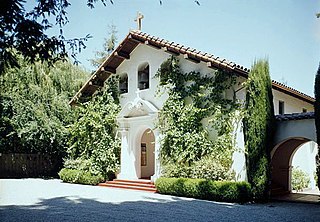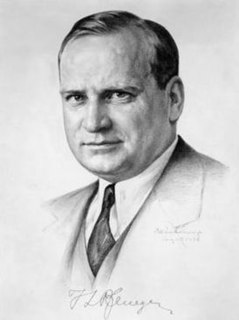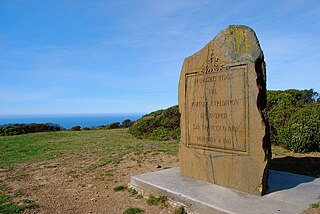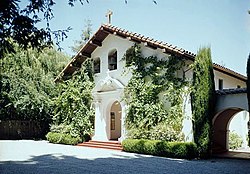
Mission San Antonio de Padua is a Spanish mission established by the Franciscan order in present-day Monterey County, California, near the present-day town of Jolon. Founded on July 14, 1771, it was the third mission founded in Alta California by Father Presidente Junípero Serra. The mission was the first use of fired tile roofing in Upper California. Today the mission is a parish church of the Diocese of Monterey and is no longer active in the mission work which it was set up to provide.

Mission San Francisco de Asís, commonly known as Mission Dolores, is a Spanish Californian mission and the oldest surviving structure in San Francisco, located in the Mission District. It was founded on October 9, 1776, by Padre Francisco Palóu and co-founder Fray Pedro Benito Cambón, who had been charged with bringing Spanish settlers to Alta California and with evangelizing the local indigenous Californians, the Ohlone. Next to the old mission is the newer and larger Mission Dolores Basilica, built in 1918 in an elaborate California Churrigueresque style.

Portola Valley is a town in San Mateo County, California. Located on the San Francisco Peninsula in the Bay Area, Portola Valley is a small, wealthy community nestled on the eastern slopes of the Santa Cruz Mountains.

Woodside is a small incorporated town in San Mateo County, California, United States, on the San Francisco Peninsula. Woodside is among the wealthiest communities in the United States, home to many technology billionaires and investment managers, with average home prices exceeding 5 million dollars. It has a council–manager system of government. The population of the town was 5,309 at the 2020 census.

El Camino Real is a 600-mile (965-kilometer) commemorative route connecting the 21 Spanish missions in California, along with a number of sub-missions, four presidios, and three pueblos. Sometimes associated with Calle Real, its southern end is at Mission San Diego de Alcalá and its northern terminus is at Mission San Francisco Solano.

Bernard Ralph Maybeck was an American architect in the Arts and Crafts Movement of the early 20th century. He was an instructor at University of California, Berkeley. Most of his major buildings were in the San Francisco Bay Area.

The Cathedral of San Carlos Borromeo, also known as the Royal Presidio Chapel, is a Roman Catholic cathedral located in Monterey, California, United States. The cathedral is the oldest continuously operating parish and the oldest stone building in California. It was built in 1791-94 making it the oldest serving cathedral in the United States, along with St. Louis Cathedral in New Orleans, Louisiana. It is the only existing presidio chapel in California and the only existing building in the original Monterey Presidio.

The Sánchez Adobe Park, home to the Sánchez Adobe, is located in Pacifica, California, at 1000 Linda Mar Boulevard, on the north bank of San Pedro Creek, approximately 0.91 miles (1,470 m) from the Pacific Ocean in Linda Mar Valley. The 5.46-acre (2.21 ha) county park, established in 1947 contains the Sanchez Adobe Historical site, designated a National Register Historical District in 1976 and is California registered landmark 391.

San Mateo Creek is a perennial stream whose watershed includes Crystal Springs Reservoir, for which it is the only natural outlet after passing Crystal Springs Dam.

Timothy Ludwig Pflueger was an architect, interior designer and architectural lighting designer in the San Francisco Bay Area in the first half of the 20th century. Together with James R. Miller, Pflueger designed some of the leading skyscrapers and movie theaters in San Francisco in the 1920s, and his works featured art by challenging new artists such as Ralph Stackpole and Diego Rivera. Rather than breaking new ground with his designs, Pflueger captured the spirit of the times and refined it, adding a distinct personal flair. His work influenced later architects such as Pietro Belluschi.

Our Lady of Lourdes Catholic Church is a Roman Catholic parish church of the Archdiocese of Saint Paul and Minneapolis located in Minneapolis, Minnesota in the United States. It was built on the east bank of the Mississippi River in today's Nicollet Island/East Bank neighborhood; it is the oldest continuously used church building in the city and is part of the St. Anthony Falls Historic District.

The San Francisco Bay Discovery Site is a marker commemorating the first recorded European sighting of San Francisco Bay. In 1769, the Portola expedition traveled north by land from San Diego, seeking to establish a base at the Port of Monterey described by Sebastian Vizcaino in 1602. When they reached Monterey, however, they were not sure it was the right place and decided to continue north. The party reached San Pedro Creek on October 31 and camped there for four nights, while scouts led by José Francisco Ortega climbed Sweeney Ridge, where they could see over the ridge toward the east, and so became the first Europeans to see San Francisco Bay on November 1.

St. Thomas Aquinas Chapel is a former Catholic chapel located in Ojai, in Ventura County of southern California. It now houses the city's museum, research library, and historical society.

The Family is a private club in San Francisco, California, formed in 1901 by newspapermen who in protest, left the Bohemian Club due to censorship. The club maintains a clubhouse in San Francisco, as well as rural property 35 miles to the south in Woodside. The Family is an exclusive, invitation-only, all-male club where the new members are "Babies", regular members are "Children" and the club president is the "Father".
James Rupert Miller was an architect active in San Francisco, California in the first half of the 20th century. Miller gained prominence after the 1906 San Francisco earthquake when his firm was one among many called upon to rebuild the stricken city.
Miller and Pflueger was an architectural firm that formed when James Rupert Miller named Timothy L. Pflueger partner. Pflueger, at the time a rising star of San Francisco's architect community, had begun his architectural career with architecture firm, Miller and Colmesnil sometime in 1907, under the tutelage of James Rupert Miller. Together, Miller and Pflueger designed a number of significant buildings in San Francisco, including the Pacific Telephone & Telegraph Company Building which was the city's tallest skyscraper for four decades.

St. Augustine's Catholic Church is a historic church in Napoleon, Ohio, United States. Located on the edge of the city's downtown, two blocks away from the Henry County Courthouse, the church is a prominent landmark in Napoleon.

The Shrine of St. Elizabeth Ann Bayley Seton is located in the Church of Our Lady of the Holy Rosary, a Roman Catholic parish church of the Roman Catholic Archdiocese of New York at 7 State Street, between Pearl and Water Streets in the Financial District of Manhattan, New York City.

Our Lady of Guadalupe Church is a Roman Catholic church in San Jose, California, located in the Mayfair neighborhood of East San Jose. It is historically important for its association with Californian civil rights activist César Chávez, who attended the church and conducted labor and community organizing activities out of old church building, which now serves as the parish hall under the name McDonnell Hall. The building was designated a National Historic Landmark in 2016.


















